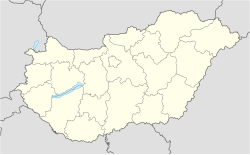Csengersima
Csengersima | |
|---|---|
Village | |
 Church from the Árpád Dynasty | |
| Coordinates: 47°52′2″N 22°44′52″E / 47.86722°N 22.74778°E | |
| Country | |
| County | Szabolcs-Szatmár-Bereg |
| Area | |
• Total | 23.8 km2 (9.2 sq mi) |
| Population (2001) | |
• Total | 741 |
| • Density | 29.71/km2 (76.9/sq mi) |
| Time zone | UTC+1 (CET) |
| • Summer (DST) | UTC+2 (CEST) |
| Postal code | 4743 |
| Area code | 44 |
Csengersima is a village in Szabolcs-Szatmár-Bereg county, in the Northern Great Plain region of eastern Hungary.
Geography
[edit]It covers an area of 23.8 km2 (9 sq mi) and has a population of 741 people (2001).
History
[edit]The village first appears in writing in 1327, when a noblewoman named Erzsébet gave a quarter of the village to her sons as dowry. The still-standing 13th century Romanesque church testifies to the existence of the village long before its appearance in writing. By 1331 the village was shared between the Szárazberek and Sima families. In 1339, László Szárazbereki was executed by Charles I of Hungary for minting counterfeit money. His land was confiscated, but eventually ended up in the hands of his brothers. After the village briefly under the control of the voivode of Maramureș in 1406, the village remained under the control of the Mikola family until the middle of the 19th century.
The village became depopulated multiple times throughout its history, including during Rákóczi's War of Independence, the 1709 plague outbreak, and the 1717 tatar invasion. During these times, the villagers usually took refuge in the Rozsály and Satu Mare castles.
Demographics
[edit]As of 2023, the village had a total population of 657. As of 2022, the town was 84.7% Hungarian, 6.9% Romanian, 3.8% Gypsy, and 1.4% of non-European origin. The remainder chose not to respond. The population was 44.8% Reformed, 10.8% Roman Catholic, and 5.2% Greek Catholic.[1]
Sightseeing
[edit]
The old Romanesque church from the 13th century is famous, mainly because of its coffered ceiling. Its ceiling contains frescoes of the celestial bodies, flowers, old Biblical scenes in a beautiful drawing and colourful manner.

Works Cited
[edit]- Balogh J. (1939): A késő-gótikus és a renaissance-kor művészete. (The late-gothic and renaissance age art.) Magyar művelődéstörténet. 2. (Szerk. Domanovszky S.), Budapest
- Bérczi Sz, Bérczi Zs., Bérczi K. (2002): Kazettás mennyezetek. (Coffered ceilings.) Licium-Art, Debrecen
- Kelemen L. (1977): Művészettörténeti tanulmányok. (Studies in Art History.) Bukarest
- Tombor I. (1968): Magyarországi festett famennyezetek és rokonemlékek a XV-XIX. századból. (Painted Coffered Ceilings from Hungary from the 15-16th Century.) Akadémiai K. Budapest
References
[edit]- ^ "Magyarország helységnévtára". www.ksh.hu. Retrieved 2024-07-22.
External links
[edit]- Short description about the church of Csengersima.
- Image from inside the church.
- Photographs of the beautiful church, outside and inside.
47°52′N 22°44′E / 47.867°N 22.733°E



